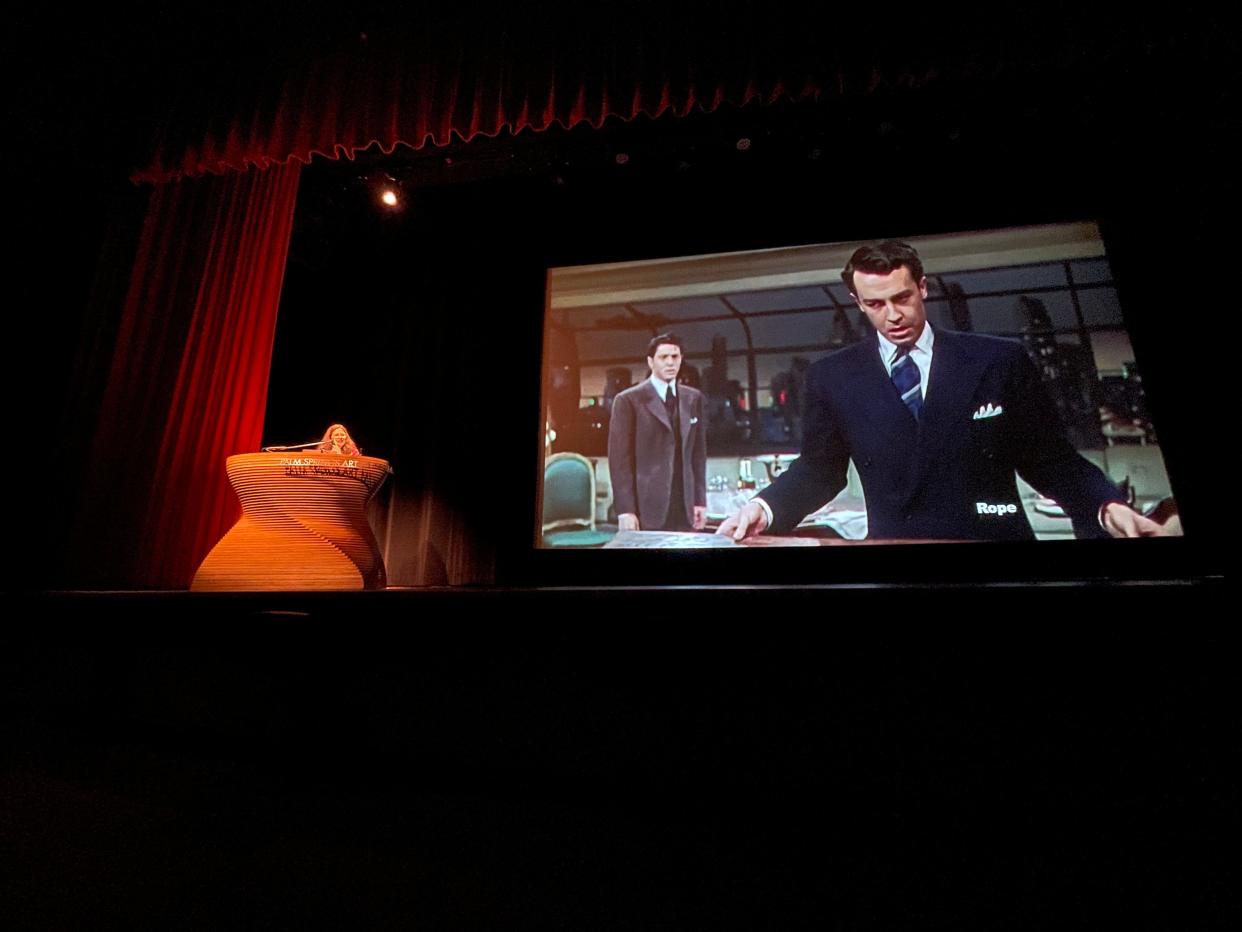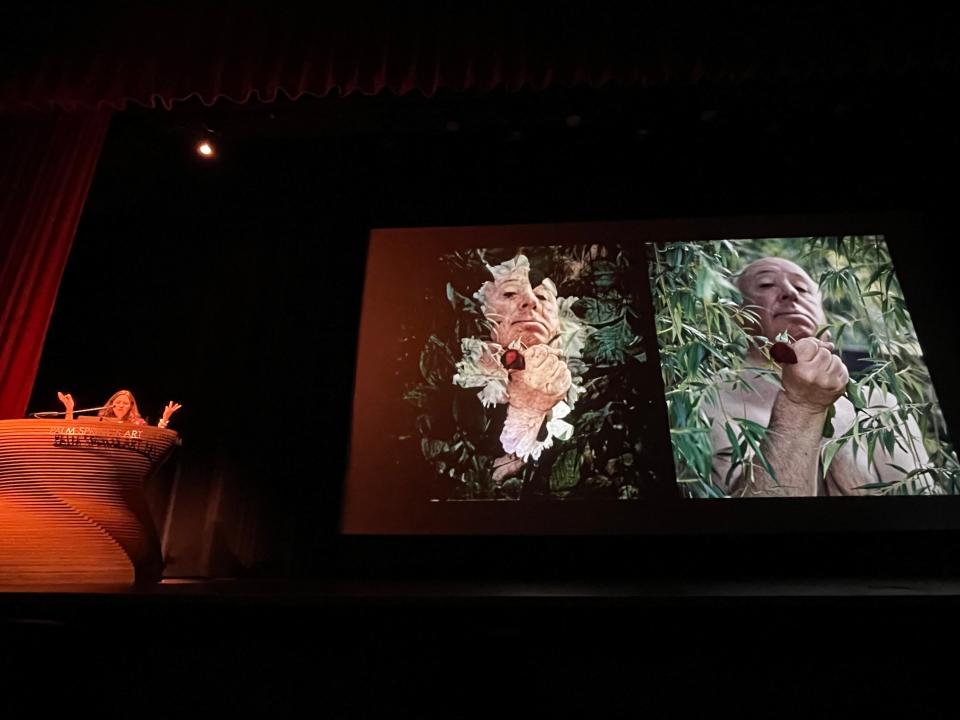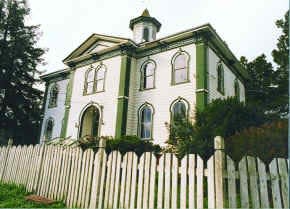Modernism Week 2023: How architecture added to the horror in Alfred Hitchcock's films

The seemingly sweet motel proprietor from "Psycho" and vicious flock of birds in "The Birds" stand out as Alfred Hitchcock's most terrifying characters, but there's another scene-stealer present in almost all of his films: architecture.
The "master of suspense," as he's been dubbed, found a way to make a standard Victorian house give viewers the creeps and make the most sleek, stylish mid-century modern home synonymous with the bad guy. But how did he do it? Author Christine Madrid French dove into the way architecture elevated the director's most famous films in her Modernism Week presentation "The Architecture of Suspense: The Built World in the Films of Alfred Hitchcock."
French refers to the "architecture of suspense" as killer skyscrapers, which open the 1958 film "Vertigo" starring James Stewart and Kim Novak, or windows "acting as the eyes of the soul, indulging our inner voyeur," in 1954's "Rear Window." Hitchcock even had a knack for taking what would appear to be a normal setting and turning it into a space of horror. A fun family day spent at the Mount Rushmore visitors center can easily turn into being at the wrong place at the wrong time as seen in 1959's "North by Northwest." In that same vein, the Mission San Juan Bautista looks like a calm, safe space to be in, but with an added tower in "Vertigo," it ends up being an unfortunate place for someone to meet their end.
The director also typecast buildings in the same way that actors might be typecast for certain roles, French said. Victorian architecture went from a cute home to a "place of terror" thanks to the Bates mansion in the 1960 film "Psycho."
"It persists in our cultural memory more than 60 years after this movie came out," French said. "These buildings played a pivotal role in each of Alfred Hitchcock's works, and they provide not just a backdrop, but a dynamic frame for the characters in the film and for you, the audience. These structures must have some kind of hypnotic allure that suggests sentience themselves or some kind of intelligent presence. The building itself is speaking to you in the movies."
Hitchcock was born in London, but he loved California, French said, and he was fascinated by its cinematic landscape and buildings. Many of his films are set and/or filmed in the Golden State, like "Vertigo," "The Birds" and "Rebecca."

In "Vertigo," in which a former San Francisco detective is hired to follow a disturbed woman, French said the director "precisely captured" what the city looked like in October 1957. Of course, because it's Hitchcock, each place ends up having a mysterious aura.
The whole movie is a "travelogue" for the city, French said, as Stewart and Novak's characters pass by a number of famous sites, like the Golden Gate Bridge and the Palace of Fine Arts. One location the author highlighted was the McKittrick Hotel, built in 1879 as a single-family house on Gough Street. It was "well-loved," she said, with many family occasions taking place there, but "it switched over in Hitchcock's vision of it into a place of intrigue and mystery." By 1959, the building had been condemned and it later burned down.
Additionally, the Empire Hotel, where Novak's character lived, was the site of tragedy. A shopkeeper who worked at department stores downtown jumped from the top of the building one month before filming for "Vertigo" began, French said. Interestingly enough, one of Novak's characters in the film, Judy Barton, was also a salesperson who met a similar demise.
"The Birds," starring Rod Taylor and Tippi Hedren, focuses on a series of sudden and unexplained violent bird attacks. French said right before production started, there was an actual seabird invasion in Santa Cruz. The director had to say he did not have anything to do with the incident nor was it promotion for the film, calling it "merely a coincidence" that art and life would have such similarities.

Similar with his other films, "your safe haven is now translated into a death trap" in "The Birds," French said, and a schoolhouse, diner or farmhouse could be the last place you want to end up in this Hitchcock classic.
When scouring locations for the film, the Potter Schoolhouse, initially a rundown, vacant building, captured production designers' attention. Though it may not look very scary at first glance, once it was outfitted with black birds and children screaming outside, it became a spot to steer clear of. The Potter Schoolhouse, today a private residence, is located in Bodega.
Perhaps the most recognizable buildings in a Hitchcock film are found in "Psycho," which centers on an encounter between on-the-run embezzler Marion Crane (Janet Leigh) and shy motel proprietor Norman Bates (Anthony Perkins).
French said the actual form of the Bates mansion is inspired by many different types of architecture that have a Second Empire style, which is distinguished by a mansard roof. Her theory is that the film's production designers, who lived in Los Angeles at the time, were inspired by the old Victorian homes in the Bunker Hill neighborhood before they were demolished.
What is it about this kind of architecture that gives people the chills, and how does Hitchcock make it even more terrifying? French said the director and his crew were playing with the notion of the uncanny valley of architecture. Originally referred to as an unsettling feeling that some people experience in response to not-quite-human figures like humanoid robots, it can also be applied to architecture in Hitchcock's films, the author said. For example, long, empty hallways he often showcases might increase one's heart rate.
Almost every single frame of "Psycho" makes one feel uncomfortable: The eerie motel off the side of the road, the steps leading up to the Bates mansion that make you want to turn around and, of course, the iconic shower that looks so innocent but ends up being so deadly.
Hitchcock's influence continues in films today. Modernism structures have been bad guys' lairs for decades, like the Elrod House in "Diamonds are Forever" or the Kaufmann House in "Don't Worry Darling" — both located in Palm Springs. "Uncanny" spaces also pop up in films such as "The Shining," "Nope" and "Parasite."
French dives into these topics more in her book, "The Architecture of Suspense: The Built World in the Films of Alfred Hitchcock," which she called "a real killer."
Ema Sasic covers entertainment and health in the Coachella Valley. Reach her at ema.sasic@desertsun.com or on Twitter @ema_sasic.
This article originally appeared on Palm Springs Desert Sun: Architecture adds to the horror, suspense in Alfred Hitchcock's films

